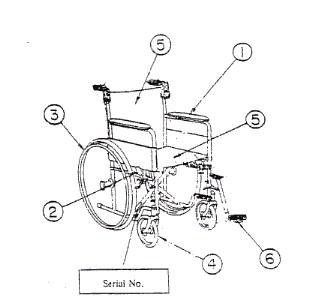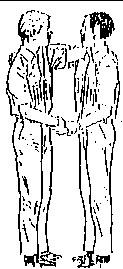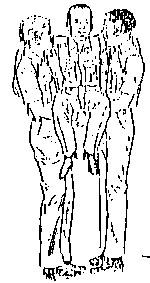Guidelines for People With Disabilities in Emergencies
Persons with disabilities should prepare for an emergency situation before hand and should be familiar with your needs during an evacuation. You are encouraged to convey these needs to your instructor at the beginning of each semester. While attending class, try to position yourself near a doorway for an easier exit. Become familiar with the building and its exits.
The following guidelines are important to follow:
- Establish a buddy system and alternate for each class.
- People with disabilities should prepare for an emergency ahead of time by instructing a classmate, instructor, supervisor, or co-worker on how to assist in the event of any emergency.
- If assistance is not immediately available, disabled people should remain near the stairwell landing or in the elevator lobby. Rescue personnel will first check all exit corridors and stairwells for those trapped. S/he should continue to call for help until rescued.
- People who cannot speak loudly, or with voice / speech impairments, should carry a whistle or have other means of attracting attention of others.
- Be familiar with alarm signals.
- Leave school materials in the room to avoid wasting time.
- Wait for rescue & remain calm.
- DO NOT re-enter a building until permitted by emergency personnel.
- Do NOT use elevators unless authorized to do so by police or fire personnel.
Evacuation for People with Disabilities
BUILDING MARSHALS and volunteers should familiarize themselves with these procedures in order to assist in planning for the evacuation of people with physical and sensory disabilities.
- Evacuating a disabled or injured person by only one person with no assistance is a last resort.
- Check on people with special needs during an evacuation, determine if they have established a "buddy system," and ensure their safe evacuation.
- Always ASK someone with a disability how you can help BEFORE attempting any rescue technique or giving assistance. Ask how he or she can best be assisted or moved, and whether there are any special considerations or items that need to come with the person.
- If the situation is life threatening, call 911.
- Do NOT use elevators, unless authorized to do so by police or fire personnel. Elevators could fail during a fire, earthquake or flood.
- Notify police or fire personnel immediately about any people remaining in the building and their locations.
Emergency Responses by Disability
- Most visually impaired persons will be familiar with the immediate area they are in and may have learned locations of exits and fire alarms in advance.
- Tell the person the nature of the emergency and offer to guide him/her by offering your left/right elbow (this is the preferred method when acting as a "Sighted Guide"). Do NOT grasp a visually impaired person‘s arm.
- Give verbal instructions to advise about the safest route or direction using compass directions, estimated distances, and directional terms or information (i.e., elevators cannot be used or if there is debris or a crowd.)
- As you walk, tell the person where you are and advise of any obstacles, e.g. stairs, overhanging objects, uneven pavement, curbs, and narrow passageways.
- When you have reached the designated Emergency Assembly Point, orient the person to where he/she is and ask if any further assistance is needed.
- Some individuals may have dog guides that may be disoriented during the emergency, and may require additional assistance.
- White canes and other mobility aids should NOT be left behind.
- Most structures are not equipped with visual (flashing light) evacuation alarms and persons with Impaired hearing may not perceive an emergency exists. An alternative warning technique is required. Two (2) methods of warning are:
- Write a note stating what the emergency is and what the evacuation route is -i.e. "Fire - go out the rear door to Parking Lot".
- Turn the room lights on and off to gain attention - then indicate through hand gestures or writing (i.e. on a blackboard) what is happening and where to go.
- Offer visual instructions to advise of safest route or directions by pointing toward exits or evacuation map.
- People who cannot speak loudly, or with voice/speech impairments, may be carrying a whistle or have other means of attracting attention of others.
- Mobility-impaired persons should not be evacuated by untrained personnel unless the situation is life-threatening. It may be necessary to help clear the exit route of debris (if possible) so that the person with a disability can move out or to a safer area.
- If people with mobility impairments cannot exit, they should move to a safer area, e.g., most enclosed stairwells, or an office with the door shut which is a good distance from the hazard (and away from falling debris in the case of earthquakes.)
- Police or fire personnel will decide whether people are safe where they are, and will evacuate them as necessary.
- If people are in immediate danger and cannot be moved to a safer area to wait for assistance, it may be necessary, only if you have had rescue training, to evacuate them using an evacuation chair or a carry technique. Carrying options include using a two-person lock-arm position, or having the person sit in a sturdy chair - preferably with arms. Before taking action, always ask the person their preferred method of assistance. (Refer to the Emergency Evacuation Tips and Overview later in this section). Check with the Building Marshal for the availability of an evacuation chair if needed.
The same procedure outlined for the Mobility Impaired should be used. Crutches, canes and walkers should NOT be left behind.
- Most non-ambulatory people will be able to exit safely without assistance out of single story buildings.
- Non-Ambulatory persons should not be evacuated by untrained personnel unless the situation is life- threatening.
- All 2+ story buildings will require persons to be carried out if evacuation assistance is required, always ask the person what method of assistance they prefer. Some people have minimal ability to move and lifting them may be dangerous to their well-being. If the person prefers to be moved in their wheelchair - only if you have had rescue training (Refer to the Emergency Evacuation Tips and Overview later in this section).
- Some people have no upper trunk or neck strength to assist in being carried out. If a seatbelt is available, secure the person if use of a chair is the method employed to carry the person to safety.
- If moving a person more than three (3) flights, a "relay team" arrangement is needed. If a wheelchair is left behind, do NOT leave it in an exit path or doorway to become an obstacle.
- Wheelchairs have many movable weak parts which were not constructed to withstand the stress of lifting (Refer to the Wheelchair Nomenclature later in this section).
- Frequently, non-ambulatory persons have respiratory complications or rely on electric artificial respirators. They should be given priority assistance if there is smoke or fumes, as their ability to breathe is seriously in danger.
- Power wheelchairs may have heavy batteries, which are difficult to remove. In this situation, the best response may be to ask the person to transfer to an evacuation chair, if one is available, so that they can be moved immediately. If it is not possible for the person to be removed from the chair (i.e., if the person uses respiratory equipment that is attached to the chair), wait for assistance. If attempting to move a power wheelchair, remove the batteries. Make sure the footrests are locked, the motor is off, and it is in neutral gear. Some power wheelchairs and scooters may not have heavy battery packs, and may be moved with little difficulty.
- If the person prefers to be removed from their wheelchair, their needs and preferences will vary. Always consult the person as to his/her preference with regard to:
- Ways of being removed from a wheelchair
- The number of people needed for assistance
- Whether to extend or move extremities when lifting because of pain, catheter leg bags, spasticity, braces, etc.
- If a seat cushion or pad should be brought along with him/her if he/she is removed from the Wheelchair.
- Being carried forward or backward on a flight of stairs.
- After-care. If a person is removed from the wheelchair (i.e. a stretcher, chair with cushion pad, or car seat) perhaps paramedic assistance might be needed
- The person will want their wheelchair retrieved as soon as possible. The wheelchair is essential to the person's mobility. Inform Public Safety of the location of wheelchairs to be retrieved.
- If an outage occurs during the day and people with disabilities choose to wait in the building for electricity to be restored, they can move near a window where there is natural light and access to a working telephone. During regular building hours, Classroom Faculty and Other Supervisory Building Occupants should be notified so they can advise emergency personnel.
- If people would like to leave and an evacuation has been ordered, or if the outage occurs at night, call the College Sheriff extension 2911 to request evacuation assistance.
EMERGENCY EVACUATION TIPS AND OVERVIEW MORE SURVIVAL SKILLS.
Evacuation is difficult and uncomfortable for both the rescuers and the people being assisted. Some people have conditions that can be aggravated or triggered if they are moved incorrectly. Remember that environmental conditions (smoke, debris, loss of electricity) will complicate evacuation efforts. The following guidelines are general and may not apply in every circumstance.
Occupants should be invited to volunteer ahead of time to assist disabled People in an emergency. If a volunteer is not available, designate someone to assist who is willing to accept the responsibility. Volunteers should obtain evacuation training for certain types of lifting techniques. Two or more trained volunteers, if available, should conduct the evacuation and relay teams established if the evacuation is more than three flights.
Always ask disabled people how you can help before attempting any rescue technique or giving assistance. Ask how they can best be assisted or moved, and if there are any special considerations or items that need to come with them. Lifting a person may be harmful. Ask their preference about being carried forward or backward down a flight of stairs. Ask whether a seat cushion or pad should be brought along. Wheelchairs were not designed to handle the stress of lifting. Batteries may have to be removed and life support equipment could be connected.
Before attempting an evacuation, volunteers and people being assisted should discuss how any lifting will be done and where they are going. Proper lifting techniques (e.g., bending the knees, keeping the back straight, holding the person close before lifting, and using leg muscles to lift) should be used to avoid injury to rescuers' backs. Ask permission of the evacuee if an evacuation chair or similar device is being considered as an aid in an evacuation. When using such devices, make sure the person is secured properly. Rest at landings if necessary. Certain lifts may need to be modified depending on a person's disability.
Bumping on a Series of Steps
In situations where the wheelchair user must be carried up or down a flight of steps it is desirable to have a minimum of two assisting persons, with four assisting person preferred for adults or heavy persons. The strongest person(s) should be placed at the back of the chair, It is also advisable to check to see if anyone has any physical condition that contraindicates lifting, such as heart condition or back problems.
Procedure:
- The wheelchair should be gripped by the handles on the back of the chair.
- If two people are assisting, one holds the hand grips; the other assists in front.
- If there are four, at least two assist in the back; each person gripping one of the handles. Where the other assisting person grips depends upon which parts of the chair are removable.
- If the wheelchair arms are removable, do NOT grip them. This must be stressed because it is the first place an assisting person will grip.
- If the leg rests are removable, do NOT grip them. The assisting person(s) who will be in front should grip a part of the wheelchair which is not removable, such as the front seat frame or leg rest (if not removable).
- DO NOT carry the wheelchair up or downstairs. This is the quickest way to back trouble for the uneducated or unheeding. ROLL the wheelchair up or down the stairs. Let the wheelchair carry the weight, not the back of the assisting person.
- Keep the wheelchair slightly tilted back to keep the wheelchair user secure. However, do not tilt too far; this makes the assisting person(s) behind the wheelchair bend too far forward; this could cause the person(s) to loose balance and pitch forward.
- Always keep the wheelchair user facing away from the stairs.
Curbs and Single Steps
There are generally two methods which can be used to assist a person in a wheelchair over a curb or single step. The wheelchair can be rolled down off the curb, or the step: backwards or forwards, Which method used depends upon the preference of the user, the environmental situation, the strength of the assisting person, and the confidence the wheelchair user has in the assistant. As in all activities, if the wheelchair user does not have sitting balance, a seat belt should be attached to the wheelchair and used.
Procedure (Backward);
This is the least taxing method on the assisting person and usually the safest for the wheelchair user, is to turn the wheelchair around until it can be rolled off the step or curb backwards.
- Just before reaching the edge of the curb or step turn the wheelchair around so that it is facing away from the edge.
- Holding tightly to the handles, back the wheelchair down off the curb. Let the rear wheels roll down over the edge. Additional support can be furnished by pressing a hip against the back of the chair as it comes off of the edge. (See figure 1.)
- To prevent the front wheels coming down with a jar that could throw the wheelchair user out of the chair, press a foot on the anti-tipping bar as the chair is backed away from the curb. Then gently lower the front wheels to the ground.
- Turn the wheelchair around, being careful not to clip the ankle of a passer-by and proceed on your way.
Curbs and Single StepsThere are generally two methods which can be used to assist a person in a wheelchair over a curb or single step. The wheelchair can be rolled down off the curb, or the step: backwards or forwards, Which method used depends upon the preference of the user, the environmental situation, the strength of the assisting person, and the confidence the wheelchair user has in the assistant. As in all activities, if the wheelchair user does not have sitting balance, a seat belt should be attached to the wheelchair and used.Procedure (Backward);This is the least taxing method on the assisting person and usually the safest for the wheelchair user, is to turn the wheelchair around until it can be rolled off the step or curb backwards.
Procedure (Forward):This method is effective if the assisting person is experienced in handling wheelchairs. It is most useful on crowded street corners and places where the wheelchair cannot be turned around to go off an edge backwards. The wheelchair user should have on a safety belt or be holding to the chair to prevent being thrown forward out of the wheelchair.
|
Procedure (Forward):
This method is effective if the assisting person is experienced in handling wheelchairs. It is most useful on crowded street corners and places where the wheelchair cannot be turned around to go off an edge backwards. The wheelchair user should have on a safety belt or be holding to the chair to prevent being thrown forward out of the wheelchair.
- As the curb is approached, place one foot on the anti-tipping bar and tip the wheelchair back on the large wheels. This keeps the wheelchair user securely in the chair as the chair rolls off the edge. The assisting person should not be supporting the weight of the wheelchair user, but just keep the wheelchair balanced on the large wheels.
- Once the front wheels are up, remove the foot from the anti-tipping bar. Continue rolling the wheelchair of the edge with the front wheels up.
- After the large wheels are off of the edge, allow the front wheels to drop down gently by pressing a foot on the anti-tipping bar as the wheels come down.
Rolling on the Rear Wheels
Can be used to roll the wheelchair over the following types of terrain: going over railroad tracks and grates embedded in the street or sidewalks; soft lawns, sand, snow, etc., even deep pile carpets. This type of terrain tend to throw the front wheels aside or cause them to sink in, making the progress difficult if not impossible. Lifting the front wheels of the surface gives the assisting person more control over the wheelchair.
If the assisting person is not strong enough (although it actually takes little physical strength if the wheelchair is kept balanced) or doesn‘t feel confident, it is advisable to turn the wheelchair around and go backwards over rough terrain, This also puts the front wheels out of the way as they are following rather than guiding the wheelchair. Remember not to tilt the chair too far backwards.
Wheelchair Nomenclature
The following represents the varying weights, lengths, and widths of wheelchairs, both electric and manual, with person in it. The American National Standards Institute states that doorway widths should be 32 inches.
| WEIGHT | LENGTH | WIDTH |
|---|---|---|
| 200 Pounds | 48 inches | 25 inches |
| 360 Pounds | 50 inches | 26 inches |
| 375 Pounds | 63 inches | 63 inches |
General Operational Guide more survival skills
How to Open/Fold Wheelchairs
To Open Chair:
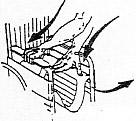
Figure 3. Tilt chair to one side, push down on seat rails
To Fold Chair:
Fold up the footplates, tilt chair to one side, and lift upward on seat rail or on upholstery next to seat rail. For chairs with detachable or offset arms (fig.4), fold by lifting carrying straps. Remove the seat cushion, back rest, or any other such additional equipment. Push heel straps (clips, leg rests, etc.) forward and fold the foot plates up. (fig 5). If seat straps are available (loops attached to either side of seat frame), grip both straps and pull up. If seat straps are not available, grip the center, front and back edges, of the seat and pull up. This should fold the wheelchair in half. Kept the seat pushed down between the frames and the back rest pushed back. This will allow for optimal closure.

Figure 4. For chairs with detachable or offset arms fold by lifting carrying straps.

Figure 5. When folding the wheelchair be sure the footplates are all the way up against the leg frames.
Methods of Assistance
Two Handed Carry
Chair Carry
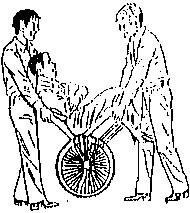
Figure 8. Place disabled individual in a chair. One person lifts the back of the chair while another lifts the front and carries the individual to safety.
Packstrap Carry
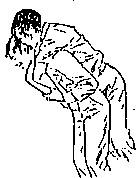
Figure 9. Place disabled individuals arms over your shoulders, cross the arms and grasp opposite wrists. Squat and bend slightly at the waist to support the disabled individual’s weight with your legs.
Packsaddle

Figure 10. Each bearer grasps one of his wrists and one of the other bearer's wrists, thus forming a packsaddle
Walking Assist
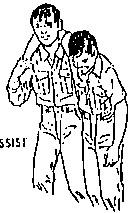
Figure 11. Drape injured individuals arm over your neck.
Carry by Extremities

Figure 12. Grab injured individual from behind and cross arms over their chest while another person grabs the injured individual by the legs.


